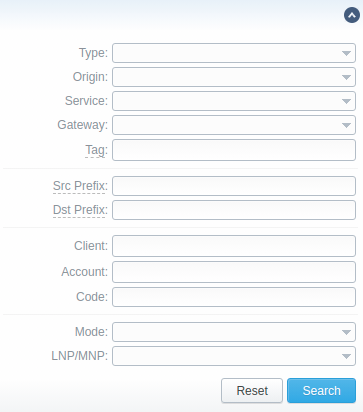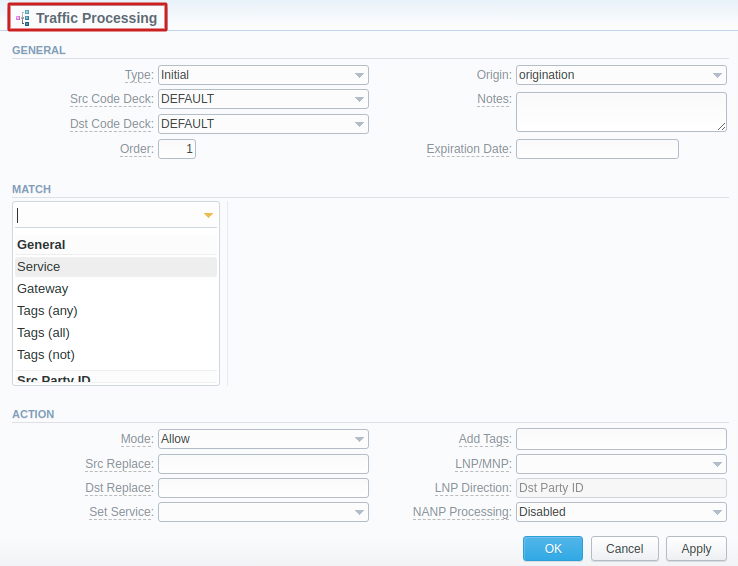Docs for all releases
Page History
...
By clicking on the Export button, you can download a current list of rules in a .csv file.
Screenshot: Rules export
| Panel | ||
|---|---|---|
| ||
|
Section overview
This section allows a user to configure and perform number translations. Here, you can add and remove rules for traffic processing. The section is presented in the form of a table of traffic processing rules with the following columns:
Screenshot: Traffic Processing section
...
Depending on rule parameters, a table can display the following scope of details:
- Name of service, the rule is created for
- Gateway, specified in a rule
- Tag(s), indicated in a rule
...
Depending on rule parameters, a table can display the following scope of details:
- Client's name, specified in a rule
- Client's account, defined in a rule
- Indicated Code
...
Depending on rule parameters, a table can display the following scope of details:
- POSIX regular expression for Src number (Src Match)
- POSIX regular expression for Dst number (Dst Match)
- Src Prefixes (Src P Any/Src P Not)
- Src Prefixes Names (Src PN Any/Src PN Not)
- Dst Prefixes (Dst P Any/Dst P Not)
- Dst Prefixes Names (Dst PN Any/Dst PN Not)
...
Depending on rule parameters, a table can display the following scope of details:
- Replacement for a matched rule for Src number (Src)
- Replacement for a matched rule for Dst number (Dst)
- List of tags added during traffic processing rule execution
...
Functional buttons/icons, presented in the section, are as follows:
...
...
...
...
...
...
...
...
...
...
...
Allows deleting a traffic processing rule from the system
Advanced Search
In the top right corner of the section above the table, an Advanced Search drop-down menu is located. By clicking on a bluedownward arrow icon, a drop-down menu with the following structure is displayed:
Screenshot: Advanced Search drop-down menu
To apply the specified search criteria, click Search; to cancel the applied parameters, click Reset.
Creating a New Traffic Processing Rule
To perform a number translation, click the Add Rule button and fill in the following fields:
Screenshot: New Traffic Processing rule
...
- Initial - execute this rule before a Client is identified
- After Client - execute this rule after client identification but before rate identification
- After Rate - execute this rule after rate identification but before routing
- After Routing - execute this rule after routing
...
Identify a code deck that will be used for Dst codes or code names filtering
...
Sets rules ordering. First matched rule will stop further number translations.
...
| borderColor | #ffffb3 |
|---|---|
| bgColor | #ffffb3 |
| borderWidth | 2px |
Attention
...
Specify the event origin:
- Origination
- Termination
...
On the Match menu, select the required parameters for a traffic processing rule. To cancel any filter, click on the delete sign next to its name.
You can start a quick search by typing filters' names in the field at the top of the Match menu.
| Panel | ||||||||
|---|---|---|---|---|---|---|---|---|
| ||||||||
Tip If, for instance, the Client filter is empty, it means that this rule will implicate all clients. |
...
A rule will work if an event has at least one of the tags, specified in this field
...
A rule will work if an event has all tags, specified in this field
...
A rule will work if an event has no tags, specified in this field
...
Specify a respective client
| Panel | ||||||
|---|---|---|---|---|---|---|
| ||||||
Please be advised that any traffic processing rule can have either the Client or Account field. |
...
Defines an action that will be executed if a traffic rule matches:
...
Define a provider for the LNP/MNP service, which will be dipped for translation
| Panel | ||||||
|---|---|---|---|---|---|---|
| ||||||
In the VCS 3.17.0, a new feature regarding TJA database has been added. Starting from this version, while creating a new rule, in the LNP/MNP field, a user can select either tja.ee (Routing Number) or tja.ee (Owner). The difference is as follows:
Please find more about TJA database here. |
...
Define if NANP processing will be used for LNP dipping:
- Enabled
- Disabled
| Panel | ||||||||
|---|---|---|---|---|---|---|---|---|
| ||||||||
| Best Practice Example To get a better understanding of how the Src/Dst Match and Src/Dst Replace fields work, let's consider the following example: If our Src/Dst number is 123#456, the Src/Dst Match field is ^123#(.*)$ and the Src/Dst Replace field is 789\1, the resulting number will be 789456. That's because the ^123#(.*)$ expression tells the system that from 123#456 number it must remember only the (.*) part, which stands for 456. Now, in the Src/Dst Replace field we have 789\1, which means that instead of 123#456, it must insert 789 + add \1 that equals (.*). Therefore, our resulting number will be 789+456=789456. These translation rules use the PostgreSQL regular expressions syntax (based on POSIX regex with some extensions). For more information, please refer to the PostgreSQL documentation portal. In addition, in the Src/Dst Replace field you can insert random number with fixed digit length using the $rnd(xxx-yyy)$ variable, where xxx - start number and yyy - end number of the range. For example, $rnd(050-950)$ will be replaced by a 3-digit random number from 50 to 950. |
Rules Import
Now, a user can import a .csv file containing a list of traffic processing rules. To do so, click the Import button and a pop-up window with the following structure will appear:
Screenshot: Traffic processing rule import
...
Specify a delimiter symbol here. The possible options are:
- Autodetect
- ,
- ;
- Tab
By default, the Autodetect option is selected.
...
Specify what to do with the current traffic processing rules:
...
By default, the Keep previous data option is selected.
When all fields are filled in, click Process>>. You will be transferred to the second step to indicate the default values in respective fields and specify rows and columns. To finish importing, click Process>> again.
Rules Export
By clicking on the Export button, you can download a current list of rules in a .csv file.
Screenshot: Rules export






